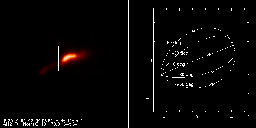Geometry of flare loops
Science nugget: Sept 12, 1998
This week, I would like to think about true geometry of flare loops, remembering
that the loops we see in images are always those projected on to the image
plane. An attempt of restoring de-projected loops was made on the famous
Hinotori flare of 13-May-81 by Loughhead,
Wang and Blows (1984), although it would be difficult to determine
from a single image all the parameters that define a loop. It is surprising
that this kind of application has never been made, to the best of my knowledge,
on Yohkoh data of flare loops. Suppose, as in the above reference, that
the loop is contained in a plane and that it is part of an ellipse, i.e.,
x^2/a^2 + (y-c)^2/b^2 = 1. If the loop is asymmetric, it may be represented
by rotating this ellipse by an angle theta. On solar surface, this structure
can stand tilted to the equator by alpha and inclined to the vertical by
beta. Therefore, even in the assumption of a planer loop at a given latitude
and longitude, we have 6 parameters (a, b, c, theta, alpha and beta) to
determine. Here, instead of trying to obtain the best set of parameters
of a loop, I will show how we can restrict them. In the following figure,
the left panel shows a bright loop in the boxed area. To model this loop,
I used a=5.0, b=4.0, c=-0.5, theta=0 and alpha=15 deg. The last information
comes from the locations of hard X-ray footpoints. The location of this
flare was at N16 W26. The right panel shows how the appearance of this
model loop changes with different inclination angles. The diamond signs
show the loop top in each case. It appears that the loop should be inclined
to north by about 30 deg. (Click on the figure to see a larger, more visible,
version.)

This kind of work is important to understand how the loop is heated,
even when multiple loops are involved. Note that in this event there is
weaker emission going southeast from the right border of the box. The simple
calculation presented here shows how the soft X-ray source would appear
to move when higher loops with the same inclination and tilt brighten at
later times, as assumed in the 2-D reconneciton model.
Nariaki Nitta 13-Sep-98 (email 'nitta'@lmsal.com).

